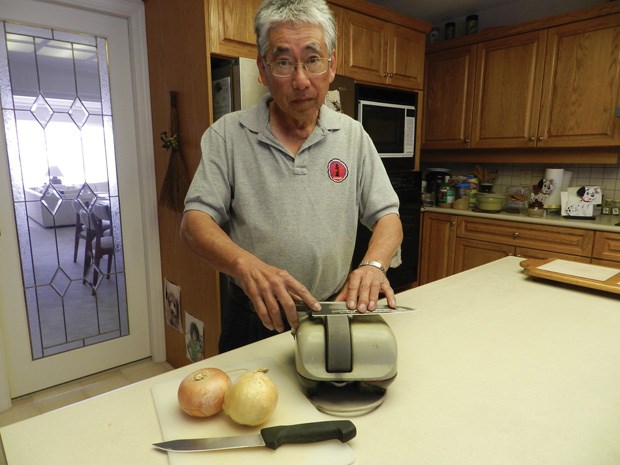When you tuck into that tasty bowl of chow mein at the Steveston Salmon Festival this July 1st, be sure to give it a closer look to see the talent and effort that went into its creation.
Because behind the expertly chopped collection of vegetables and pork are years of experience courtesy of a brigade of dedicated volunteers, some of whom have been lending their unique chopping talents for several decades.
Leading the list are those from the Steveston Bhuddist Temple’s Ladies’ Auxiliary.
“They are amazing. The core of them must be in their 80s,” said Joanne Nicholson said. And they are amazing choppers, because we go through a lot of vegetables.”
Their secret?
Many in the group are former fish filleting line workers from BC Packers’ Imperial Plant in Steveston which used to be located across the road of the Steveston Community Centre on Moncton Street.
“These ladies have amazing knife skills,” Nicholson said.
One person who saw their handiwork up close as manager of the filleting line in the old fish plant before it’s processing lines closed in 1997 was Martin Kuramoto.
“A good filleter takes about a year to learn how to do their job properly. And a good one can produce somewhere around 25 pounds of fillets an hour,” said Kuramoto who regularly attends the chow mein preparation day, bringing along his special sharpening equipment to keep the group’s knives in tip top shape. “They are so efficient in what they do, there’s no wasted motion.”
That kind of skill comes in handy when you consider they help chop a huge amount to ingredients to serve around 2,300 portions that are all freshly prepared.
Each year, the chow mein effort goes through 250 lbs. of celery, 200 lbs. of onions, 175 lbs. of bean sprouts and 100 lbs. of ground pork.
“It’s always pork,” Nicholson said. “It’s never vegetarian or chicken. And that’s because you get the most flavour out of the smallest amount of pork.”
It’s also MSG-free and served with soy sauce.
The chopping group of about 50 to 70 assembles a day or two before the Salmon Festival and work out of the community centre’s kitchen and adjacent meeting space. They bring along with them their own knives and cutting boards and are then shown the size and shape of the chopped vegetables to produce.
“We ask them to do it as uniformly as possible so it all cooks together evenly,” Nicholson said. “At one time I thought maybe we should use Cuisinarts or mandolins, because our help is not going to be around forever. But we found that according to the exacting standards of the chow mein recipe, you have to use a sharp knife and cut everything by hand.
“So, we stand in a little bit in awe of those ladies,” she said, adding their willingness to help comes from the roots in the Japanese-Canadian community in Steveston. “They just have that ingrained sense of commitment.”
Most years the chow mein booth has a line up as customers patiently wait.
Nicholson based its popularity on the taste and fact it acts as a fundraiser for numerous groups attached to the Steveston Community Centre.
“It’s a good cause. It’s one of the booths that is directly raising funds for the community centre,” she said, adding volunteer help comes from a variety of sources.
“We get help from the judo, kendo and karate clubs, plus the Japanese language school that uses the Japanese Cultural Centre,” Nicholson said.
“I guess we can also hang the label of tradition on its popularity. It’s also the style of Japanese-Canadian chow mein,” she added.



